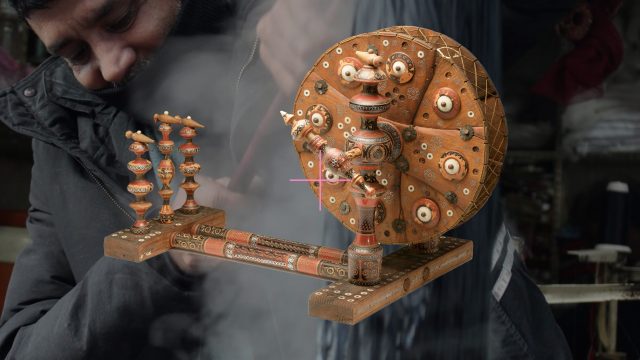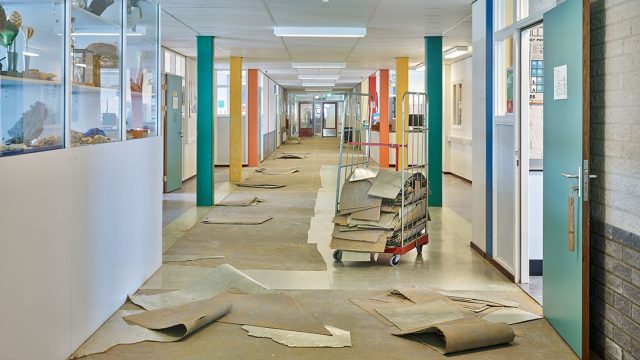Questions that are essential to the successful conservation of objects on loan to the V&A often seem out of place or silly to the lenders in Disobedient Objects. For lenders ‘Not An Alternative‘, this discrepancy arose in the standard question of ‘Where/how is the object currently stored?’ Jason Jones stored their loan – a way-finder street sign for Occupy Sandy – amongst the items in his backyard’s shed. This road sign’s journey to the V&A is not entirely singular. As objects in service of a larger struggle, ‘Disobedient objects were not made with a museum in mind‘.
Yet their exceptional status is all the more reason to care for these objects. In this post Senior Preservation Conservator Clair Battisson goes behind the scenes, and introduces the unique challenges in Conservation for ‘Disobedient Objects’.
It’s a marathon not a sprint!
A very brief overview of exhibition delivery from a conservation point of view
Getting an exhibition into a gallery is a lengthy, collaborative process. Every exhibition has a dedicated Project Team consisting of representatives from departments within the Museum such as Exhibitions, Curators, Conservation and Visitors Services, to name but a few.
Disobedient Objects contains a wide and varied selection of objects and material types and as a result most of the Conservation sections are involved. To reflect the Museum’s diverse collections, the Conservation Department is divided into sections of specialist conservators who care for specific material types: paper, books; painting; furniture; textile; sculpture; ceramics; glass and metal. We have Conservation Scientists, who analyse materials and provide preventive and environmental advice and a Condition Statement Administrator who generates and produces documents that accurately record an object’s condition, which is very important with any loaned-in objects and touring exhibitions. Documentation is kept as imaged-based as possible. A good quality digital image, which can be viewed on a screen or tablet, can provide a lot more detail than a written statement.
Directed by the exhibition content, a Conservation Liaison is appointed for each project and the relevant Conservation Studio Representative assigned. The Liaison is responsible for keeping the Reps informed and the Reps are responsible for any objects that fall under their specialist area. Each object is considered individually and any preventive measures, environmental recommendations, necessary treatments and display requirements are discussed and agreed. As a member of the Project Team, the Liaison must have an overview of the objects and the exhibition’s design (3D, 2D and lighting). The Liaison works closely with the exhibition: Coordinator, Assistant, Curator, Designer, Lead Technician and Conservation Reps, to assure object access and safe display.
Each object is unique and has its own display requirements. For example, a garment may require a mannequin with bespoke underpinnings produced by Textile Conservation or a page opening of a book may need a Perspex book mount carefully measured by Book Conservation and fabricated by Technical Services. Should an exhibition tour, we need to be certain any mounts produced can be reused or modified at future venues. The original purpose of an object and the option of displaying it as it was meant to be used or seen is taken into account. However, the stability, portability, value and the message of an object will also guide what is possible.


When an object is displayed outside of the traditional boundaries (ie: framed, cased, metre reach touch distance, barriers and relevant signage such as ‘do not touch’), a carefully planned contingency is established. As Disobedient Objects has a number of objects that will be on open display without barriers or correlating museum signage, a plan has been agreed, which can be progressively introduced to safeguard the objects while maintaining visitor experience. This includes designing an adjustable mount system, fully briefing Visitor Service staff regarding vulnerable objects and a sensitive message at the beginning of the exhibition will ask visitors to both enjoy and respect the objects on display.
The Lead Technician, Installation Team, Exhibition Staff, Curators and Conservators work together during installation. Occasionally loan objects arrive during installation, meaning anything the object requires has to be agreed and produced within a very tight timeframe.
Once installed and open to the public vulnerable objects are checked on a regular basis and open display objects are lightly cleaned as required. From a preventive perspective, any bug traps laid during installation receive regular checks for signs of activity and organic material may also need monitoring.
That was a whirlwind introduction to exhibition delivery from a conservation point of view. Some of the Disobedient Objects have started arriving on site, and as the project progresses Conservation will post more updates.


